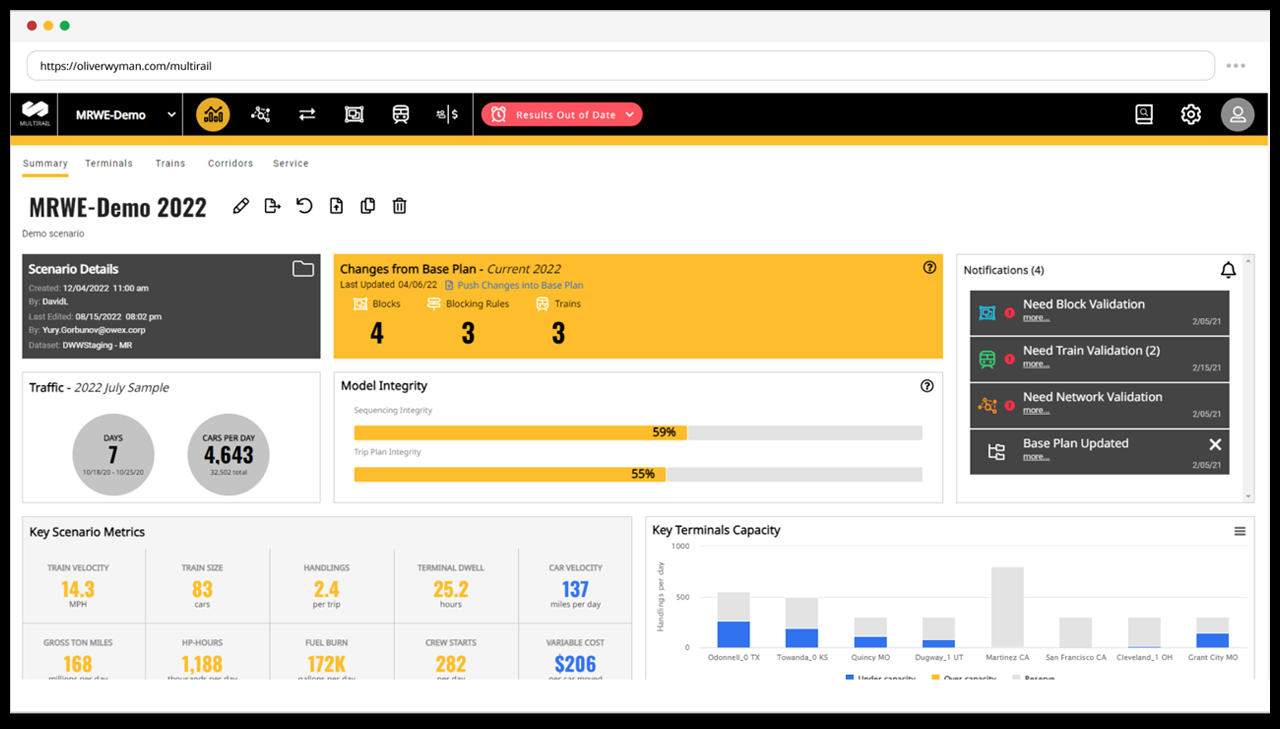
Supply Side: Oliver Wyman, Genesis
Written by Marybeth Luczak, Executive Editor
Oliver Wyman’s MultiRail rail service-design planning software has been upgraded. The new edition, MultiRail Web, can be hosted on premises or in the cloud.
Oliver Wyman releases MultiRail Web, a rail service-design planning platform that can be hosted on premises or in the cloud. Also, Salt Lake City, Utah-based Genesis Electronics Group acquires Glīd, LLC, whose “patent-pending technology” is slated to offer a new way of shipping existing semi-trailers via rail.
Oliver Wyman’s MultiRail rail service-design planning software has been upgraded. The new edition, MultiRail Web, can be hosted on premises or in the cloud.
Among the MultiRail Web platform features:
- A web-based suite of tools “to maximize flexibility and customization, with the latest security authorization technology to enable remote access,” according to Oliver Wyman.
- A dashboard for easy access to data. Navigational aids are said to allow users to move quickly between plan adjustments and analytics.
- Plan improvement suggestions and optimization that Oliver Wyman said will allow users “to test and improve their current plans.”
MultiRail Web “provides a layered toolset for railroad planners to comprehensively manage traffic, trains, blocks and assets,” according to Oliver Wyman. Users “can easily and accurately manage service design processes and analytics using either historical or forecast traffic data” and the multi-user collaborative interface provides “diagnostic levers to ensure the most efficient routing and handling of traffic, along with tools to eliminate errors and loose ends in the operating plan.” MultiRail Web also allows a next-day, next-month, next-quarter, or next-year modeling approach.
The platform is said to help users:
- Consolidate work, crew, fuel, inspection, DPU, helper and other train events, and ensure that trains operate within capacity limitations.
- Plan yard workload and activity types by shift or day of week, and within capacity limitations.
- Improve car connections in yards, explore new block-builds that allow for reductions in downstream handlings, and ensure that areas of dwell and excessive work are reduced.
- Build local service plans for modeling of local train operations, ensure that serving yard capacity is adequate for local needs, and track customer switching and/or blocking commitments.
- Manage interfaces between corridors and yards, and ensure that corridors have sufficient capacity for non-scheduled train slots and maintenance events.
- Evaluate and contrast different plan scenarios by reviewing simulation results with capacity awareness, operational metrics, and resources and costs estimation.

Genesis Electronics Group on Oct. 26 reported acquiring Glīd, LLC, a Utah-based autonomous electric shipping technology firm that Genesis CEO Braden Jones co-founded. Genesis said it authorized half of the $4 million purchase price to be paid in the form of convertible preferred stock and the remainder in the form of a convertible note.
Glīd’s technology would enable “two specially-made ‘Glīder’ vehicles to independently and autonomously move under an unaltered fully-loaded semi-trailer, connect to both the king pin and rear axel, and then lift the trailer,” Genesis said. “Once the trailer is lifted off the ground, the Glīders, using a uniquely designed wheel system, will be able to enter railroad tracks (via forked rail spurs, asphalt or concrete roads), deploy rail wheels, and then transport the semi-trailer and travel at speeds of up to 70-80 mph” on battery power.
“Each Glīder can exit the rails onto a private lot, where a semi-tractor could then pick it up and take it on the final leg of its destination,” Genesis said.
Glīd is expected to become a carrier, building and operating its own fleet of Glīders.
Jones said “traditional shipping companies could make more money by shipping cargo long distances with us, which would enable their fleets to focus on shorter routes.” Additionally, Glīd is slated to provide railroads “with revenue from freight that has not traditionally been hauled over the rails.”
Among the advantages of using Glīders, Jones said, are: “autonomous driving over the rails is drastically safer than over the road”; “removing semi-trailers from the road will reduce congestion, accidents and the trucking industry’s carbon footprint”; and “battery ranges [for Glīders] will go further [on railroad tracks] due to reduction of friction as well as the ability to carry more battery weight over the rails.”
Genesis said that prototype Glīder units will be operational and moving demonstrable cargo in the next four-to-six months. “After these units pass the rail industry standard safety measures, they can become fully deployable,” Genesis reported.
In related developments, Culver City, Calif.-based Parallel Systems in February 2022 was awarded a $4.4 million U.S. Department of Energy grant to test its autonomous, battery-electric-powered railcar technology. Additionally, Intramotev, a St. Louis, Mo.-based technology startup, has developed an autonomous freight car, the TugVolt, that can be used for short hauls in standard railroad interchange service.



